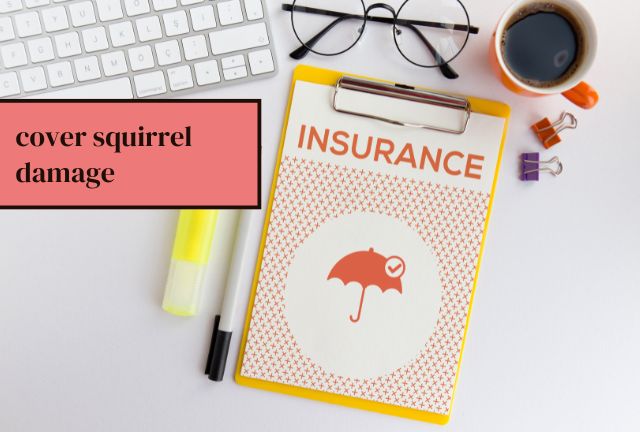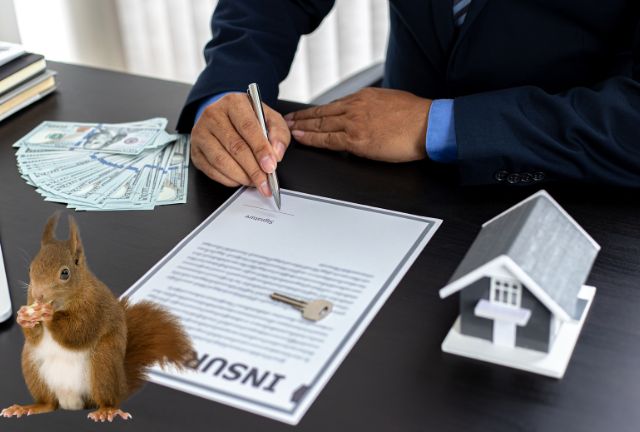Does state farm homeowners insurance cover squirrel damage? When it comes to protecting your home from unexpected incidents, understanding what your homeowners insurance covers is essential. One common question homeowners have is whether State Farm insurance includes coverage for damage caused by squirrels. In this article, we’ll delve into the specifics of State Farm’s coverage for squirrel damage, exploring what may or may not be covered under their homeowners insurance policies.

Squirrel damage coverage with State Farm insurance
1, Understanding Squirrel Damage Coverage with State Farm
Does State Farm Homeowners Insurance Cover Squirrel Damage? State Farm homeowners insurance typically covers certain types of damage caused by squirrels, but it’s important to understand the specifics:
- Sudden and Accidental Damage: State Farm is likely to cover sudden and accidental damage caused by squirrels, such as if a squirrel chews through electrical wiring leading to a fire or damage to your home.
- Exclusions for Gradual Damage: However, coverage may not apply to gradual damage caused by squirrels, such as ongoing deterioration of wood or insulation due to nesting or chewing.
2, Exclusions and Limitations
It’s crucial to be aware of the exclusions and limitations related to squirrel damage under State Farm homeowners insurance:
- Gradual Wear and Tear: State Farm policies typically exclude coverage for damage that occurs gradually over time, including damage caused by pests like squirrels if it’s deemed a maintenance issue.
- Maintenance-Related Issues: If squirrel damage is a result of neglected maintenance or failure to take preventive measures, it may not be covered by State Farm insurance.
Does State Farm Homeowners Insurance Cover Squirrel Damage? State Farm’s coverage for squirrel damage may vary based on individual policy terms and conditions, so homeowners should review their policy documents or consult with a State Farm agent for specific details.
3, Additional Coverage Options
State Farm offers homeowners additional coverage options to address squirrel damage and related issues:
Optional Endorsements or Riders: Homeowners concerned about squirrel damage can inquire about specific endorsements or riders available through State Farm. These additions may provide broader coverage for wildlife-related damage that might otherwise be excluded from standard policies.
- Example: State Farm may offer an “Animal Damage Endorsement” that extends coverage to certain types of wildlife damage, including damage caused by squirrels.
Comparison of Coverage Options: Compare the cost and coverage details of optional endorsements or riders with State Farm. Evaluate whether adding supplemental coverage for squirrel damage is a cost-effective solution based on your location and potential risks.
- Example: Compare the cost of adding wildlife damage coverage to your State Farm policy versus potential out-of-pocket expenses for squirrel-related repairs.
4, Preventative Measures
Does State Farm Homeowners Insurance Cover Squirrel Damage?Taking proactive steps to prevent squirrel damage can help mitigate risks and potential insurance claims:
Sealing Entry Points: Seal openings or gaps in your home’s exterior to prevent squirrels from entering and nesting inside.
- Example: Use caulk or wire mesh to seal gaps around utility lines, vents, and eaves.
Trimming Tree Branches: Keep tree branches trimmed away from your home to limit squirrels’ access to the roof and exterior walls.
- Example: Regularly trim overhanging branches that could provide a pathway for squirrels to reach your home.
Using Deterrents: Install motion-activated deterrents or repellents to discourage squirrels from nesting or foraging near your property.
- Example: Place motion-activated sprinklers or ultrasonic devices in areas where squirrels are active to deter them from approaching.
Regular Maintenance: Schedule routine inspections and maintenance to identify and address potential squirrel entry points or damage early.
- Example: Inspect your attic, crawl spaces, and roof periodically for signs of squirrel activity or potential entry points.

Understanding State Farm coverage for wildlife damage
5, Consultation with a State Farm Agent
Consulting with a State Farm agent is crucial to understanding specific coverage options and recommendations for squirrel damage:
Policy Review: Schedule a meeting or phone call with a State Farm agent to review your homeowners insurance policy in detail. Discuss coverage limits, exclusions, and any available endorsements related to squirrel damage.
- Example: Ask the agent to clarify whether squirrel damage is covered under your current policy and inquire about options to enhance coverage if needed.
Personalized Guidance: Receive personalized guidance from a State Farm agent based on your location, property type, and specific concerns about squirrel-related risks.
- Example: The agent may recommend adding wildlife damage coverage based on the prevalence of squirrels in your area and potential risks to your property.
6, Comparing State Farm with Other Insurers
Compare State Farm’s approach to squirrel damage coverage with other insurers:
Coverage Variations: Research how other homeowners insurance providers handle squirrel damage claims compared to State Farm. Compare coverage options, exclusions, and optional endorsements available.
- Example: Compare State Farm’s policy with a competitor’s policy to understand differences in coverage for wildlife-related damage.
Customer Experiences: Explore customer reviews and testimonials to gauge satisfaction with squirrel damage coverage among different insurers.
- Example: Read online forums or review sites to see how homeowners rate their experiences with filing squirrel damage claims through various insurance companies.
7, Educating Homeowners on Squirrel Damage Risks
Does State Farm Homeowners Insurance Cover Squirrel Damage? Educate homeowners on the risks associated with squirrel damage and the importance of proactive measures:
Potential Risks: Highlight the potential risks of squirrel-related damage, such as electrical fires, structural damage, and insulation deterioration.
- Example: Provide statistics or real-life examples of property damage caused by squirrels to emphasize the importance of preventative measures.
Preventative Strategies: Offer practical tips and strategies for preventing squirrel damage, such as sealing entry points, using deterrents, and regular property maintenance.
- Example: Create a checklist of preventative actions that homeowners can take to minimize the risk of squirrel-related incidents and protect their property.
Does State Farm Homeowners Insurance Cover Squirrel Damage? By consulting with a State Farm agent, comparing coverage options with other insurers, and educating homeowners on squirrel damage risks and prevention, individuals can make informed decisions to protect their homes and assets effectively.